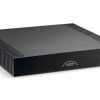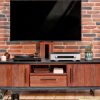In the history of recorded sound, multichannel surround sound at home is a relatively recent phenomenon. Many of us grew up with stereo, and the younger iPod and MP3 generation still do much of their listening using stereo ear buds and headphones. They may be exposed to surround sound in commercial movie theaters but for the most part they’re still listening to 2-channel stereo through their earbuds.
There’s nothing wrong with that. After all, it’s an illusion of a musical event, a performance that originally was recorded live or in a studio that’s being reproduced in the earbuds or headphones of the listener. For many, stereo is enough to convey a pleasurable musical experience.
But when questions of musical fidelity arise, there are persuasive arguments for using more than two channels of sound for music reproduction. Even discounting some high-end enthusiast’s embrace of two-channel stereo, there’s still surprising resistance to using surround sound for music reproduction. I’ve noted the resistance in some email requests for advice that are sent my way or to my Axiom colleagues.
Two Ears, Two Speakers?
It may be based on the simple idea that we have just two ears, so therefore two speakers are all we need for a convincing replication of an acoustical event. This of course ignores the extraordinary sophistication of our brain/hearing mechanisms, which can instantly analyze and compute the direction of sounds happening all around us, based on the arrival times, delays, and relative loudness of those sounds (that’s a simplified description).
Over the years, at various audio shows and CES events, I occasionally ran into J. Gordon Holt, the founder of Stereophile magazine, with whom I shared similar views on a number of audio subjects. During the course of an interview in 1997, conducted by Steven Stone for Stereophile, Holt was asked whether surround sound recording and playback would further the cause of musical fidelity. His response was perceptive:
Holt: “Well, sure. I mean, it just goes against all common sense to believe that you can reproduce sounds that normally come at you from all directions through just two speakers in front of you.”
The Hafler Circuit
I’ve shared that view for decades, and my first experiments with using more than two stereo speakers go back to the Hafler circuit, invented in the late ’60s/early ’70s by Dynaco founder and engineer David Hafler. (Gordon Holt also experimented with the Hafler setup.) The Hafler circuit was a simple way to retrieve ambient information “hidden” in lots of stereo recordings in the form of out-of-phase channel difference signals. They were reproduced over two rear speakers wired in series connected to the positive feed from each front left and right channel amplifiers. Back then, it was the only way to extract hidden ambience, and when it was set up properly, there was an uptick in realism, especially with live concert recordings. Ambient reflections and audience applause were routed to the two rear speakers and the system did not require an extra amplifier. It didn’t include any artificial delay or reverb, only the out-of-phase difference signals between the main left and right channels. (Nowadays, of course, decoding algorithms from Dolby, dts, and Logic7 will extract this information from stereo recordings and route it to side and rear speakers. Discrete digital 5.1 surround sound takes this even further. In many ways, early Dolby Surround owes a huge debt to David Hafler.)
Some readers may recall an article of mine some years back that went into more detail about the intrinsic limitations of stereo for music reproduction. Here’s an excerpt:
Big Two-Channel Flaw
The flaw–and it’s huge–which intrinsically limits stereo’s ability to create the sense that we’re in the same acoustic space as the musicians is that all the reverberant information contained on a stereo recording is fired back at us from two speakers at the front of the room. If you think about it for a moment, it never happens that way live in a concert hall, studio, club, or arena. Yes, sounds come from the on-stage musicians directly to our ears (and to the two stereo microphones), BUT they’re also reflected from the side walls, the ceiling and the back wall, and reach our ears a few milliseconds later.
Those tell our ears and brain the size of the acoustic space, the position of the musicians within that space, and our location relative to the musicians. And it’s the directions and delays of those reflected sounds that must be preserved intact–and replayed in your listening room from the same direction. That is what convincingly recreates the illusion of the hall and space. To be fair, two stereo channels will also register those reflected sounds, but they reproduce them from the front of the room, and that’s where the stereo illusion falters. When you hear live music, sounds arrive from a multiplicity of directions. Our remarkably sophisticated hearing is constantly analyzing the time and level (volume) differences of sounds as they arrive at each of our ears (and go around our head, slightly delayed and reduced in strength in reaching the other ear) from all directions.
Stereo cannot convey this information from two channels at the front of your room.
Expanded Space and Depth
What we sometimes describe as “warmth” in reproduced sound, which can mean a number of things, including slightly boosted bass and upper bass, can also refer to the effect a listener experiences switching from pure stereo playback to surround sound using a 5.1-channel setup and any of the ProLogicII, dts, or Logicp7 decoding schemes. Certainly in almost all cases, listeners experience a big jump in realism when the side and rear surround speakers are engaged. The soundfield seems to become much more spacious, with increased depth and natural ambience. (With some studio multi-miked recordings, using DPLII, dts Neo:6 or Logic7 surround decoding may produce bizarre and inappropriate placement of some instruments or vocals in the surround channels. If that happens, turn off the surround and listen in stereo.)
If stereo-only devotees are willing to shed their biases and listen carefully, eyes closed, to first stereo, then to surround sound with good recordings, all but the most stubborn will admit that there is an extra dimension added by surround sound music enhancement. Things collapse to a smaller stage at the front of the room when the surround is switched off. Turning on the surround decoding immediately restores the sense of ambient space and depth.
In cinemas, there has never been any reluctance to increase the number of channels in order to enhance the realism of the movie experience. Audio engineers as early as the 1950s recognized the big jump in realism when they introduced magnetic-stripe multi-channel sound (up to six channels) with the earliest wide-screen processes, and Dolby Stereo surround sound became a fixture of movie houses world-wide.
There may be other reasons that discourage listeners from enjoying the relatively huge benefits of both home theater and music surround sound.
It is more complicated to set up, and more expensive. Interior design conscious spouses often resist the additional speakers necessary at the sides of the room for effective surround sound. Most, however, are persuaded once they hear it.
Certainly, surround sound can’t improve a terrible movie or a bad recording. But paired with a fine studio or live recording or a beautifully scored and mixed movie soundtrack, surround sound in the home is one of the affordable luxuries that our rich history of invention has brought about.
Related Articles:
An Essential Guide to Home Theater Speaker Placement
Understanding Speaker Frequency Response
How Many Audio Channels are Enough?





























